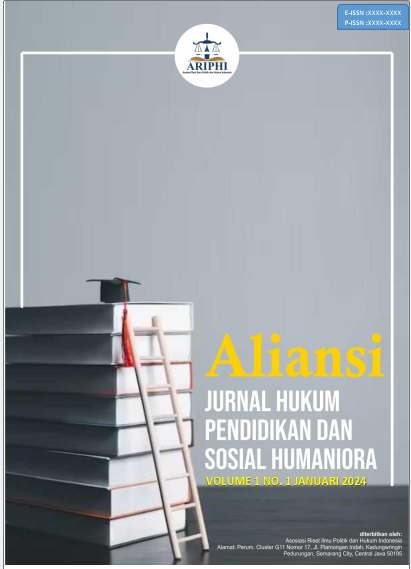Prosedur Pemberhentian Presiden atau Wakil Presiden dalam Masa Jabatannya Menurut Sistem Ketatanegaraan Republik Indonesia
DOI:
https://doi.org/10.62383/aliansi.v1i6.573Keywords:
Dismissal Procedure, Implications, President, Vice PresidentAbstract
The Unitary State of the Republic of Indonesia is a unitary state in the form of a Republic, where the Head of State and Head of Government is the President and assisted by a Vice President in carrying out his duties. The term of office of the President and Vice President according to the 1945 Constitution is 5 years and can be re-elected in the next period. The President and/or Vice President may be dismissed during their term of office for various reasons. This research is a normative juridical research, namely, research conducted by reading works related to the procedure for the dismissal of the President and/or Vice President and the implications of the dismissal of the president and/or deputy in his term of office according to the constitutional system of the Republic of Indonesia. The results of this study show that: (1) The procedure for the dismissal of the President and/or Vice President during their term of office before the amendment of the 1945 Constitution has not been regulated in a limitative manner. Prior to the amendment, the MPR was the highest state institution that had the authority to dismiss the President and/or Vice President during his term of office. After the amendment of the 1945 Constitution, the procedure for dismissing the President and/or Vice President during his term of office has been regulated in Article 7B of the 1945 Constitution. (2) The dismissal of the President and/or Vice President during his term of office has implications for the continuation of the government and the life of the community in the future.
Downloads
References
Abdul Mukthie Fadjar. (2006). Hukum konstitusi dan Mahkamah Konstitusi. Jakarta: Sekretariat Jendral dan Kepaniteraan Mahkamah Konstitusi RI.
Abdy Yuhana. (2013). Sistem ketatanegaraan Indonesia pasca perubahan UUD 1945. Bandung: Fokusmedia.
Adventus Toding. (2017). DPD dalam struktur parlemen Indonesia: Wacana pemusnahan versus penguatan. Jurnal Konstitusi, 14(2).
Bagas Hendardi. (2017). Sistem pemerintahan negara Indonesia. Yogyakarta: Istana Media.
Bagir Manan. (2003). Lembaga kepresidenan. Yogyakarta: FH UII Pers.
Dian Aries Mujiburahman. (2013). Impeachment presiden: Mekanisme dan alasan pemberhentian presiden menurut UUD 1945. Yogyakarta: Kotak Buku.
Erman Syarif. (2012). Pemakzulan presiden dan/atau wakil presiden berdasarkan Undang-Undang Dasar Negara Republik Indonesia Tahun 1945.
Fajar, M., & Yulianto, A. (2010). Dualisme penelitian hukum normatif dan empiris. Yogyakarta: Pustaka Pelajar.
Frits Marannu Dapu. (2014). Sistem ketatanegaraan Indonesia sebelum dan sesudah amandemen. Lex Administratum, 2(3).
Hufron. (2018). Pemberhentian presiden di Indonesia: Antara teori dan praktik. Yogyakarta: LaksBang Pressindo.
Ibrahim, J. (2006). Teori dan metodologi penelitian hukum normatif. Malang: Bayu Media Publishing.
Ketetapan Majelis Permusyawaratan Rakyat No. III/MPR/1978.
Kusnardi, & Ibrahim, H. (1983). Pengantar hukum tata negara. Jakarta: Pusat Studi Tata Negara FH UI.
Laica Marzuki. (2006). Berjalan-jalan di ranah hukum. Jakarta: Sekretariat Jenderal dan Kepaniteraan Mahkamah Konstitusi Republik Indonesia.
Marwono. (2021). Demokrasi dan sistem pemerintahan. Malang: Inteligensia Media.
Marzuki, P. M. (2012). Penelitian hukum. Jakarta: Kencana Prenada Media Group.
Monteiro, J. M. (2020). Metode penelitian dan penulisan hukum. Yogyakarta: Deepublish.
Munif Rochmawanto. (n.d.). Pembagian kekuasaan antara MPR, DPR, dan DPD dalam mewujudkan sistem ketatanegaraan yang berkedaulatan rakyat. Jurnal Independent, 2(1).
Peraturan Mahkamah Konstitusi No. 21 Tahun 2009.
Rendy Adiwilaga, Yani Alfian, & Ujud Rusdia. (2018). Sistem pemerintahan Indonesia. Yogyakarta: Deepublish.
Retno Saraswati. (2012). Desain sistem pemerintahan presidensial yang efektif. MMH, 41(1).
Reza Syawawi. (2010). Pengaturan pemberhentian presiden dalam masa jabatannya menurut UUD 1945: Studi komparatif sebelum dan sesudah perubahan. Jurnal Konstitusi, 7(6).
Simbolon, L. A. (2009). Lembaga-lembaga negara (di dalam Undang-Undang Dasar Republik Indonesia Tahun 1945). Yogyakarta: Deepublish.
Soemitro, R. H. (1990). Metodologi penelitian hukum. Jakarta: Ghalia Indonesia.
Sutarto. (2019). Sistem pemerintahan Indonesia. CV Graha Printama Selaras.
Tri Mulyani. (2016) Kajian Normatif Mengenai Hubungan Antar Lembaga Negara Dalam Sistem Ketatanegaraan Republik Indonesia Berdasarkan Undang-Undang Dasar Tahun 1945: Sebelum Dan Sesudah Amandemen. Humani, Vol.6 No. 1.
Tutik, T. T. (2010). Konstruksi hukum tata negara Indonesia pasca-amandemen UUD 1945. Jakarta: Kencana.
Undang-Undang Dasar 1945 sebelum amandemen.
Undang-Undang Dasar Negara Republik Indonesia Tahun 1945.
Yudi Suprayanto, & Amin Suprihatini. (2018). Mengenal lembaga negara Indonesia. Klaten: Saka Mitra Kompetensi PT.
Zed, M. (2007). Metode penelitian kepustakaan. Jakarta: Yayasan Obor Indonesia.
Downloads
Published
How to Cite
Issue
Section
License
Copyright (c) 2024 Aliansi: Jurnal Hukum, Pendidikan dan Sosial Humaniora

This work is licensed under a Creative Commons Attribution-ShareAlike 4.0 International License.





